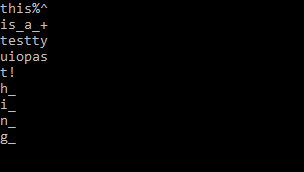22
1
Challenge:
Given a list of multi-line strings, overlap them (in the top-left) and output the result.
Example:
Input: ["aaaa\naaaa\naaaa\naaaa","bb\nbb\nbb","c"]
Output:
cbaa
bbaa
bbaa
aaaa
Challenge rules:
- Input-format is flexible. You are allowed to get the input as a 2D list of lines (i.e.
[["aaaa","aaaa","aaaa","aaaa"],["bb","bb","bb"],["c"]]) or 3D list of characters (i.e.[[["a","a","a","a"],["a","a","a","a"],["a","a","a","a"],["a","a","a","a"]],[["b","b"],["b","b"],["b","b"]],[["c"]]]). You are allowed to take all the inputs one by one through STDIN. Etc. - Output format is strict. You can choose to print or return the multi-line string. (If your language doesn't have any strings, outputting as a 2D list of characters is allowed as alternative. But only if your language doesn't have strings at all.)
- The order of the input-list is of course important (but you are allowed to take the input in reverse if you choose to).
- Inputs will only contain printable ASCII in the unicode range \$[33,126]\$ (
!"#$%&'()*+,-./0123456789:;<=>?@ABCDEFGHIJKLMNOPQRSTUVWXYZ[\]^_`abcdefghijklmnopqrstuvwxyz{|}~). - Inputs will only be rectangles (so no weird shapes). The output aren't necessary rectangles, though.
- Trailing spaces and a single trailing newline is allowed. Leading spaces and/or newlines not.
General rules:
- This is code-golf, so shortest answer in bytes wins.
Don't let code-golf languages discourage you from posting answers with non-codegolfing languages. Try to come up with an as short as possible answer for 'any' programming language. - Standard rules apply for your answer with default I/O rules, so you are allowed to use STDIN/STDOUT, functions/method with the proper parameters and return-type, full programs. Your call.
- Default Loopholes are forbidden.
- If possible, please add a link with a test for your code (i.e. TIO).
- Also, adding an explanation for your answer is highly recommended.
Test cases:
Input: ["aaaa\naaaa\naaaa\naaaa","bb\nbb\nbb","c"]
Output:
cbaa
bbaa
bbaa
aaaa
Input: ["12345\n54321","00\n00\n00\n00","001\n011\n012"]
Output:
00145
01121
012
00
Input: ["sm\noo\nmr\nee\nt!\nh_\ni_\nn_\ng_","!@#$%^\n&*()_+\nqwerty\nuiopas","this\nis_a\ntest"]
Output:
this%^
is_a_+
testty
uiopas
t!
h_
i_
n_
g_

Are trailing newlines allowed? Or more specifically, is an arbitrary amount of trailing newlines allowed? – JAD – 2019-06-05T14:29:53.840
@JAD Yeah sure, why not. As long as the rest is output without any leading spaces/newlines. Trailing newlines/spaces aren't really important, so can optionally be added. – Kevin Cruijssen – 2019-06-05T17:29:42.003